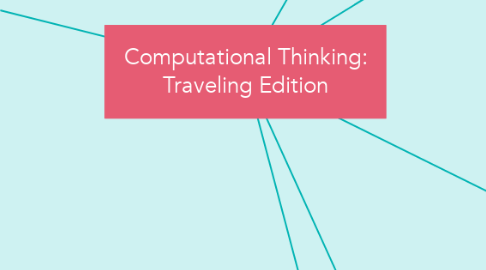Computational Thinking: Traveling Edition
by Erica Martin Bagby

1. References:
1.1. Google Computational Thinking for Educators. (n.d.). What is computational thinking? Retrieved from https://computationalthinkingcourse.withgoogle.com/unit
1.2. International Society for Technology in Education & Computer Science Teachers Association. (2011). Operational definition of computational thinking for K-12 education. Retrieved from http://www.iste.org/docs/ct-documents/computational-thinking-operational-definition-flyer.pdf?sfvrsn=2
1.3. Yadav, A., Hong, H. & Stephenson, C. (2016). Computational thinking for all: Pedagogical approaches to embedding 21st century problem solving in K-12 classrooms. TechTrends, 60(6), 565-568.
2. Problem Description: Rebecca is traveling to London with two friends, Eric and Kathleen. Kathleen is used to the life of luxury and prefers to stay in a nice hotel room. Eric, on the other hand, would like to travel on a more of a budget. He prefers to stay in a less expensive location such as a hostel or lower end motel. Rebecca has been given the task of choosing where the trio will stay. She wants to be able to please all parties.
3. Decomposition: To break down the problem into smaller pieces, Rebecca turns to Trip Adviser, Trivago and Booking.com to research the components that are common among high-end hotels as well as hostels and motels in the area. She needs to find an option that will be within Eric’s price range while meeting Kathleen’s higher standard.
3.1. Rationale: This is an example of the decomposition concept in that it takes the bigger problem - finding a place to stay that meets everyone's needs, and breaks it down into smaller, more manageable pieces - what are the components of each option that encompass the desires of each party (Google, n.d.).
4. Pattern Recognition: Through her research, Rebecca finds that the common traits of hotels include amenities such as a private room/bathroom, an included breakfast, a mini-fridge/microwave, proximity to attractions, a concierge to assist in travel arrangements, and sometimes a fitness facility or pool. Hostels feature both private and shared rooms/bathrooms, a more affordable price, proximity to attractions or public transportation, and few amenities.
4.1. Rationale: By searching through online travel tools, Rebecca find patterns, trends, and regularities in the data (Google, n.d.). In the case the regularities in the data include prices, amenities, location, etc. of the hotels/motels/hostels available.
5. Algorithmic Design: Rebecca finds an option that will please everyone – AirBnb. Using the filters on the site, she is able to filter the results to ensure Kathleen is able to get the amenities she is accustomed to while staying in Eric’s budget. She sets the price, chooses the number of bedrooms to ensure a private room, selects Entire Home so as not to be sharing a space with other guests and/or hosts, and can select options on a map to choose a location with proximity to attractions and/or public transportation in the area. The final selection is an apartment, in close proximity to two underground stations, with two private rooms, a private bathroom, and a full kitchen including refrigerator/freezer, microwave, oven, stove, washing machine, etc. The host of the location provides breakfast (though not as grand as a hotel breakfast), and recommendations for local food/attractions in the area. The host serves as the concierge with open communication through the AirBnb app.
5.1. Rationale: Rebecca has taken the needs of her friends and designed a list of components of each that she then puts into AirBnb's website, using it as a tool to help solve her problem. This fits ISTE/CSTA's definition of CT in that she has formulated the problem at hand in a way that a computer/tool may help solve it (ISTE & CSTA, 2011).
6. Abstraction: While playing around on AirBnb, Rebecca finds that this may be a great option while traveling to any city on any budget. Travelers can choose from very inexpensive options in which rooms or homes are shared to the high-end luxury homes with multiple bedrooms and levels to themselves for comfort and extravagance. Varying levels of amenities are available including pools, gyms, hot tubs, free parking, etc. She realizes that she will likely never stay in a hotel ever again, and she may even look into hosting an AirBnb herself out of the spare room in her house as a source of income for her family.
6.1. Rationale: This exemplifies abstraction as it takes the solution for this specific incident and applies or transfers it to similar problems (Yadav, 2016). In this example, it even goes on to solve future problems Rebecca may not have every thought of using this solution to solve a problem of needing extra income, but it helped provide a solution for that as well.


